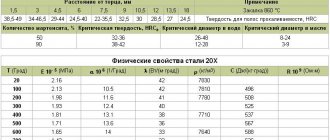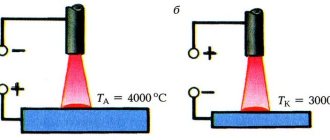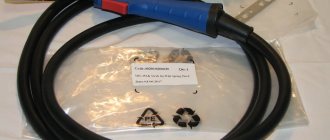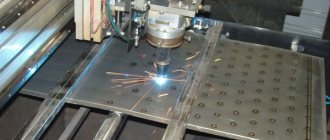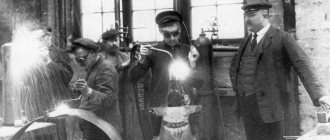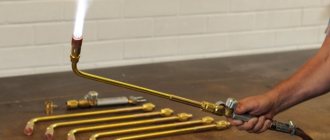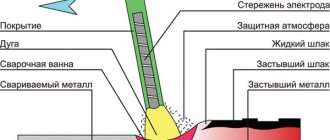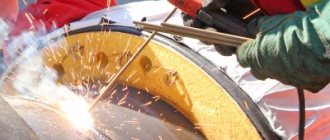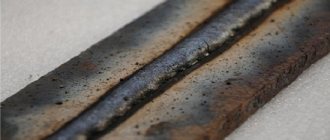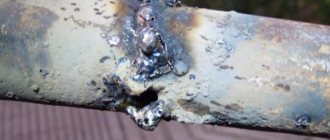In modern industry, there are more than a hundred methods of welding metals and non-metallic materials. The quality of work as a whole depends on the correct choice of production technology and welding equipment. When choosing a method, the specialist takes into account several main factors, including:
- conditions of production and operation of the finished structure;
- chemical composition of metal alloys;
- thickness of workpieces;
- maximum strength of the weld seam;
- load intensity.
To do this, a specialist needs to know the properties of metals, their resistance, be able to design welded structures, and calculate the permissible load. These and other areas of training are covered by the engineering specialty “Equipment and technology of welding production (code – 03/15/01).
Admission conditions
Future engineers are trained through bachelor's programs. Admission is possible only if you have completed secondary education (11 grades).
Applicants take entrance exams:
- physics (major subject);
- mathematics;
- Russian language;
- foreign language (at the discretion of the university).
Forms of training – full-time and part-time. The duration of full-time study is 4 years, part-time study is 5 years.
Disciplines
In the process of learning welding technologies, students study the following subjects:
- Electrical engineering.
- Basics of welding production.
- Theory of welding processes.
- Theoretical mechanics.
- Applied mechanics.
- Materials Science.
- Materials technology.
- Design of welded structures.
- Metallurgy.
- Heat treatment of welded joints.
- Technology and equipment of the welding process by fusion, pressure, thermal cutting.
- Basics of corrosion of welded joints.
- Quality management of welding production.
- Automation and design of technical systems.
- Economics of production.
- Design of auxiliary equipment.
- Other disciplines.
The specialist training program includes educational and practical training. Students undergo practical training at machine-building factories, in welding shops of other industrial plants, and in university laboratories.
Upon completion of training, graduates take a state exam and defend their thesis.
WELDING PRODUCTION
Welding production includes a large group of technological processes of joining, disconnecting (cutting), surfacing, soldering, spraying, sintering, local processing of materials, etc. These processes involve the use of thermal, thermomechanical or electrical energy at the processing site. The most widely used thermal processes use the energy of chemical reactions (combustion of flammable gases in oxygen), electrical energy (electric arc, electroslag, plasma, electron beam processes, etc.), as well as sound and light energy (ultrasonic, laser welding, cutting processes , piercing holes, heat treatment, etc.). Thermomechanical welding uses heat and the work of mechanical compression (gas press, induction, contact, diffusion welding, etc.).
Sanitary and hygienic working conditions during welding are determined mainly by the peculiarities of technological processes performed using various energy sources, so we will briefly consider the most common of them.
Thermal class of welding processes. Arc welding. The most versatile and common heat source used for fusion welding is the electric arc. Welding is carried out with consumable or non-consumable electrodes. To isolate the arc and molten metal from air, gas, gas-slag or slag protection is used. Inert gases (argon, helium) or carbon dioxide are used as gas protection.
Welding with a coated metal electrode is widely used. The coating contains substances necessary for stable combustion of the arc, creation of gas and slag protection of the metal from air and for physical and metallurgical processing of liquid metal in order to improve its quality (ferroalloys). The composition of the coatings includes ferroalloys (ferromanganese, ferrosilicon, ferrotitanium) and some other components.
Submerged arc welding is carried out using automatic and semi-automatic machines. This type of arc welding is characterized by the fact that the arc burns in a gas bubble, reliably protected from air by a layer of molten flux-slag and solid flux. The flux layer also protects the surrounding area from harmful arc radiation.
Electron beam welding. The essence of electron beam welding is to use the kinetic energy of electrons accelerated by an electric field with a high potential difference to heat and melt metal. A device that produces a narrow, focused electron beam with a high energy density is called an electron gun. Electron beam welding is usually carried out in a vacuum of 10-2 - 10-3 Pa.
Light beam welding. Recently, industry has increasingly used the energy of a light beam produced using optical quantum generators (OQGs) or lasers. Laser radiation is characterized by a number of unique properties: high monochromaticity, a significant degree of coherence, high power and high directivity. In welding production, the most promising are gas lasers, which have fairly high powers and efficiency. They are successfully used for welding and cutting metals. The high thermal power density (above 108 – 109 W/m2) with modern laser technology allows not only to melt, but also to evaporate all known materials.
Plasma processing of materials. When plasma welding, cutting or spraying materials, the heat source is a plasma jet, which is a stream of ionized particles with high energy. To produce a plasma jet, special devices called plasma torches or plasmatrons are used. Plasma torches use an arc discharge of considerable length, burning in a relatively narrow water-cooled channel. Depending on the composition of the medium, the temperature of the gas discharge plasma in an arc stabilized by a water vortex is 20,000 – 30,000 °C.
2. Thermo-mechanical class of welding processes. Joining metals using high-temperature heating and plastic deformation of the metal was the first type of welding that man created. This type was forge or forge welding. Subsequently, the development of pressure welding followed the path of improving heating sources, methods of plastic deformation, methods of cleaning and protecting the surfaces being joined.
Electric resistance welding. Its variety is spot welding. In spot welding, the parts to be joined are clamped between the electrodes of the machine and a high current is passed through them, heating and melting the metal. After the metal hardens under pressure, a weld point is formed that firmly connects both parts.
Welding with high frequency currents. The welding method is based on high-frequency heating of the surfaces to be joined to welding temperatures and compression of these surfaces. For welding with high frequency currents, 2 methods of energy transmission are used: contact and induction. With the contact method, a high-frequency current (usually radio frequency more than 60 kHz) is supplied to the heated elements. Induction heating is carried out using a special device called an inductor.
Diffusion welding in vacuum. This welding method is carried out due to the mutual diffusion of atoms of the contacting parts under relatively long-term exposure to elevated temperature and slight plastic deformation. To protect the metal, welding is usually carried out in a vacuum. Various energy sources are used to heat the parts being connected, but induction heating with high-frequency currents is most widely used.
3. Mechanical class welding processes. Welding processes belonging to this class are performed without preheating the parts being connected. The most common type of this class is cold welding. It is carried out under significant plastic deformation due to the high pressure of the metals being connected, as a result of which an interatomic bond is established between them.
Ultrasonic welding is also carried out without preheating. The connection during ultrasonic welding occurs as a result of the combined effect on the parts of shearing high-frequency mechanical vibrations, accompanied by heating of the metal, and compressive pressure.
Sanitary and hygienic characteristics of working conditions. The considered welding methods differ sharply in their sanitary and hygienic characteristics. The most unfavorable sanitary and hygienic conditions are characteristic of the thermal class of technological processes performed in air directly in the worker’s breathing zone, i.e., primarily for manual electric arc welding.
The main hazards of the electric arc welding process are welding aerosol containing dust, vapors and gases, for example, fluoride compounds, carbon monoxide, nitrogen oxides, ozone, etc. UV radiation, splashes of molten metal and slag. The composition of dust and gases generated during welding depends mainly on the composition of the electrode coatings. The basis of the dust is iron oxides, and the impurities are compounds of manganese, chromium, nickel, vanadium, molybdenum and other metals included in the welding wire, coating or molten metal.
The most harmful effects are caused by manganese oxides and fluoride compounds. Their content is usually small compared to iron oxides, but due to their toxicity they are of decisive importance when choosing the type of electrodes and coatings. It is necessary to use electrodes with the lowest content of manganese and fluoride compounds.
All types of welding produce ozone and nitrogen oxides (mainly nitrogen oxide, and in some cases nitrogen dioxide). When the carbon contained in the metal is incompletely burned, carbon monoxide is formed. In the arc zone, carbon monoxide is formed due to the dissociation of carbon dioxide, which is used as a shielding gas. Ozone, nitrogen oxide and carbon monoxide are highly toxic.
The dust generated during welding is highly dispersed, the number of particles with a diameter of less than 1 micron is 98 - 99%. Long-term exposure to welding aerosol can cause electric welders to develop pneumoconiosis.
The electric arc is a high-temperature energy source with a temperature of about 6000 ºC, therefore it is a source of radiant energy of a wide range (infrared, visible, ultraviolet).
The high brightness of the welding arc (up to 15,000 stilb) can cause blinding and damage to the retina; Intense UV radiation leads to acute occupational eye injury - photo- or electroophthalmia, and can also cause ultraviolet burns to unprotected skin.
Prolonged exposure to radiant energy from welding arcs with insufficient eye protection can lead to the development of a chronic disease of the organ of vision - cataracts.
Automatic and semi-automatic submerged arc welding significantly improve the welder’s working conditions. In this case, the arc burns under a layer of flux and its harmful effect on the organs of vision is eliminated. In addition, the risk of burns from metal splashes is eliminated. However, the air environment is polluted by gases and dust particles, the composition and quantity of which depend mainly on the composition of the fluxes used. The gross dust emission with this welding method is many times less than with manual welding.
The aerosol concentration in the welder’s breathing zone is 5.1 – 12.2 mg/m3. The concentration of manganese oxides in the breathing zone of workers servicing machines ranges from 0.11 to 0.7 mg/m3.
When welding with a non-consumable tungsten electrode in an argon environment, the main hazard is ozone, as well as the thermal effect of an open arc. The release of electric welding aerosol and manganese oxides is small.
The most unfavorable sanitary and hygienic conditions occur when spraying and cutting metals using the electric arc method and using a plasma jet. These processes are accompanied by strong gas and dust pollution in the air, many times exceeding the maximum permissible values. The toxicity of the hazards depends on the materials processed. When plasma spraying and cutting metals, harmful factors include noise, dust, gases, thermal and ultraviolet radiation. Noise during plasma processing occurs due to the passage of plasma at supersonic speed through the narrow opening of the torch nozzle and exceeds permissible standards. The total level of sound and ultrasonic pressure in the working area reaches 120 - 130 dB. Increased ultraviolet and infrared radiation, high-frequency noise and ultrasound, air pollution with aerosols require a set of protective measures during plasma processing, including sheltering installations in fume hoods, using noise-attenuating attachments on plasma torches, and using personal protective equipment for the welder’s eyes, ears, and face.
When working with lasers, the greatest danger is to the eyes and skin. A laser beam has thermal, photochemical and mechanical effects on biological objects. The danger is posed not only by the direct laser beam, but also by the reflected beam. The danger is increased due to the fact that the laser radiation may be in an invisible area. In all cases, the laser beam path must be inaccessible to workers. The hygienic advantage of laser welding is that, due to the high energy concentration and local heating, the amount of harmful substances released during laser welding is small. Even more favorable sanitary and hygienic conditions are typical for electron beam welding. Welding is carried out in a vacuum in special chambers. Air is pumped out from the working chamber by vacuum pumps and released outside the working room, so no contaminants enter the room. The danger for workers is, as with laser welding, intense radiation from the molten metal, as well as X-ray radiation resulting from electron bombardment. The latter circumstance requires the creation of protection against X-ray radiation in electron beam installations.
Thermomechanical and mechanical classes of technological processes are usually much better than thermal ones in terms of sanitary and hygienic conditions. When resistance welding, the welding current reaches tens of thousands of amperes, which creates powerful electromagnetic fields. High-intensity high-frequency electric fields are an unfavorable factor when welding with high-frequency currents. Effective reduction of high-frequency field strength is achieved by shielding high-frequency installations.
The most favorable sanitary and hygienic conditions in this class are provided by diffusion welding in a vacuum, which does not leave any air pollution in the working areas.
Ultrasonic welding is characterized by the effect of ultrasonic vibrations on the human body.
Among the occupational diseases in welders, pneumoconiosis, a type of siderosis, is possible. It occurs in a relatively favorable form of diffuse sclerotic changes. Inhalation of welding aerosol and irritating gases causes chronic occupational bronchitis. Chromium compounds can cause asthmatic bronchitis and damage to the mucous membrane of the nose and respiratory tract.
The phenomena of manganese intoxication among welders are rarely recorded and usually in the form of mild forms.
Operators servicing plasma installations (which generate extremely intense noise) may develop occupational cochlear neuritis.
Preventive actions. A radical way to optimize the working conditions of welders is the currently intensively implemented automation of welding operations and the use of robotics. The creation and maintenance of normal sanitary and hygienic working conditions in welding production is achieved by using a system of preventive measures.
Removal of welding dust and gases from the working area is carried out primarily with the help of local ventilation for stationary and non-stationary welding stations. Due to the fact that the efficiency of local ventilation is less than 100%, assembly and welding shops must also be equipped with general supply and exhaust ventilation. Mechanical exhaust ventilation from the upper zone is provided by axial exhaust fans. To compensate for the air removed by exhaust ventilation, its organized inflow must be ensured.
The fight against noise is carried out both during the creation of equipment and when placing it in production premises. Where it is impossible to reduce the sound power level, for example during plasma processes, personal protective equipment is used - anti-noise headphones or earplugs. It is necessary to achieve complete automation of such processes with the removal of operators from the noise zone.
Individual means are also used to protect the respiratory system. If the concentration of gases in the air is low, respirators can be used. At high concentrations of harmful substances (when welding in wells, tanks, vessel compartments and other closed volumes), it is necessary to use hose gas masks with forced air supply.
In recent years, methods for supplying fresh air to the welder’s breathing zone - directly under the shield - have been developed and received a high hygienic assessment.
To protect surrounding people from the radiant energy of welding arcs, permanent welding stations - cabins - are equipped or screens are installed.
To protect the eyes and face of welders, they use special shields and masks with protective light filters from the blinding visible part of the radiation spectrum, ultraviolet and infrared rays.
Personal protective equipment includes overalls and special footwear for welders.
Particular attention is paid to means of protection against radiation, the harmful effects of which depend on the power, dose, type of radiation, distance from sources, etc., so strict control of radiation is also important.
Medical and preventive measures also play an important role in ensuring the health of workers in welding production. These include mandatory preliminary and periodic medical examinations, the timing and scope of which are regulated by Order No. 90 of the Ministry of Health of the Russian Federation. It is advisable for welders to periodically stay in sanatoriums and undergo courses of special physiotherapeutic procedures.
Skills
The training program is structured so that a certified specialist has all the necessary skills for independent work in his specialty and can:
- Create conditions for the production of technologically advanced, high-quality products.
- Ensure its quality control at all stages of the industrial process.
- Take direct part in the refinement, modernization and implementation of new technologies in production.
- Create conditions for safe work, prevention of work-related injuries and occupational diseases.
- Select basic and additional materials to complete a specific order.
- Determine the most progressive method of production.
- Experiment with processing workpieces, analyze the results and draw conclusions.
- Test the physical and chemical properties of blanks and finished products and improve them.
- Develop rational proposals and submit them for consideration by management.
- Use standard and non-standard methods for designing new products.
- Perform design and technical work, prepare drawings and other related documentation.
- Clearly distribute responsibilities among subordinates, monitor the completeness and timeliness of completion of assigned tasks.
Which electrodes to choose
In order to start learning to weld correctly, you need to select welding materials in accordance with the materials being welded and their thickness. It is better to choose ordinary low-carbon structural steels as a training task. Widely used coated electrodes are suitable for them.
Electrodes for welding machines
They usually study on electrodes with a diameter of 3 mm, 1.6 and 2 mm are used to work with thin-walled structures, and 4-6 mm are used for welding thick-walled workpieces.
Most often, electrodes with a diameter of 3 millimeters (three) are used at home. Thinner ones are suitable for welding thin-walled parts, and numbers four and five are for thick elements.
The power of the device must correspond to the diameter of the electrode (or its number). In the user manual (and on the device body) there is a table for determining the operating current depending on the number.
Universities
- Russian State University of Oil and Gas named after Gubkin.
- Moscow Automobile and Road Transport State Technical University.
- National Research University MPEI.
- Moscow State Technical University STANKIN.
- Moscow Polytechnic University.
- MEPhI.
- Moscow Technical University named after Bauman.
- Baltic State Technical University Voenmekh.
- St. Petersburg Polytechnic University named after Peter the Great.
- Samara National Research University named after Academician Korolev.
- Vologda State University.
